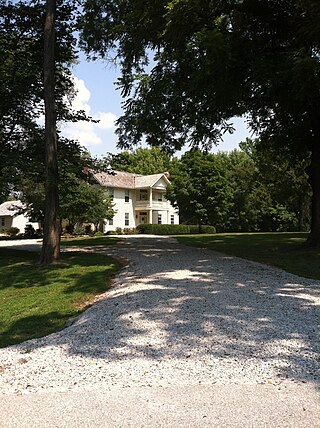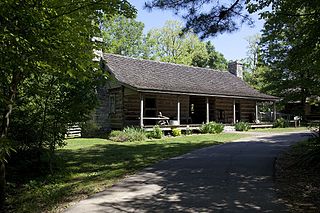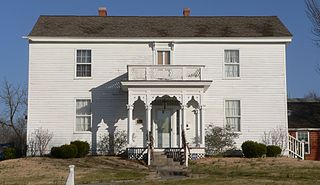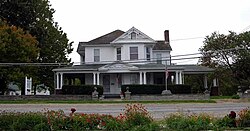
California is a city in and the county seat of Moniteau County, Missouri, United States. The 2010 census has the population at 4,278. California is the third largest city in the Jefferson City, Missouri Metropolitan Statistical Area, as well as the largest city in Moniteau County.

The Missouri State Capitol is the home of the Missouri General Assembly and the executive branch of government of the U.S. state of Missouri. Located in Jefferson City at 201 West Capitol Avenue, it is the third capitol to be built in the city. The domed building, designed by the New York City architectural firm of Tracy and Swartwout, was completed in 1917.

David R. Francis Quadrangle is the historical center of the University of Missouri in Columbia, Missouri. Known as The Quad, it is the oldest part of Red Campus and adjacent to Downtown Columbia at the south end of the Avenue of the Columns. At its center are six Ionic columns, all that remains of the original university building Academic Hall. Twelve buildings front the modern quadrangle including the domed main administration building Jesse Hall, the tallest building in Columbia. The Quad was designed and constructed by architect Morris Frederick Bell and his assistant William Lincoln Garver. It is named after Missouri governor David R. Francis. Eighteen structures, including the entire quad and most of Red Campus are listed as the Francis Quadrangle National Historic District. An obelisk, the original tombstone of Thomas Jefferson, stands in front of the Chancellor's Residence. It was gifted to the University by Jefferson's descendants in recognition of Missouri's ties to Virginia. In front of Jesse Hall stand markers honoring university president Richard Henry Jesse and Missouri governor David R. Francis. Nearby is another obelisk in memory of Missouri's first U.S. senator David Barton, The Missouri School of Journalism is located at the northeast corner of The Quad, comprising Walter Williams Hall, Neff Hall, Gannet Hall, along with the Reynolds Journalism Institute. To the west, Switzler Hall is the oldest academic building on campus, though the Residence on the Quad, home of the chancellor, is the oldest building overall. The University of Missouri College of Engineering completes the west side. Pickard Hall is currently closed due to radiation contamination from turn of the century experiments. Swallow Hall was recently renovated and houses the Departments of Anthropology, Visual Studies and Ancient Mediterranean Studies.
Switzler Hall is an academic hall on the campus of the University of Missouri in Columbia, Missouri. The building was completed in 1872, and it is located on the west side of the David R. Francis Quadrangle. Switzler Hall is the oldest academic building and second oldest structure on campus after the Chancellor's Residence. The building was named after Colonel William Franklin Switzler, editor and publisher of the Missouri Statesman and supporter of the University. Today the building houses the Department of Communication, Women's and Gender Studies, and the Special Degrees Program. The building is listed on the National Register of Historic Places.

Midtown is a neighborhood in St. Louis, Missouri. It is located 3 miles (4.8 km) west of the city riverfront at the intersection of Grand and Lindell Boulevards. It is home to the campus of Saint Louis University and the Grand Center Arts District.

Liberty Hall, also known as the Governor William Livingston House, located on Morris Avenue in Union, Union County, New Jersey, United States, is a historic home where many leading influential people lived. It was documented by the Historic American Buildings Survey (HABS) in 1938. The house was added to the National Register of Historic Places as a National Historic Landmark on November 28, 1972, for its significance in politics and government. It is now the Liberty Hall Museum.

The William Paca House is an 18th-century Georgian mansion in Annapolis, Maryland, United States. Founding Father William Paca was a signatory of the Declaration of Independence and a three-term Governor of Maryland. The house was built between 1763 and 1765 and its architecture was largely designed by Paca himself. The 2-acre (8,100 m2) walled garden, which includes a two-story summer house, has been restored to its original state.

The Guitar House, previously known as Confederate Hill, is a historic home located in Columbia, Missouri. It was built between 1859 and 1862 and is a two-story, Italianate style dwelling. It has a low-pitched hipped roof, tall slender windows with segmented arches, decorative eave brackets, and a single-story front porch with square supports. The house was constructed by David Guitar, an officer in the Union forces during the American Civil War. The house was added to the National Register of Historic Places in 1993.

Downtown Columbia is the central business, government, and social core of Columbia, Missouri and the Columbia Metropolitan Area. Three colleges — the University of Missouri, Stephens College, and Columbia College — all border the area. Downtown Columbia is an area of approximately one square mile surrounded by the University of Missouri on the south, Stephens College to the east, and Columbia College on the north. The area serves as Columbia's financial and business district and is the topic of a large initiative to draw tourism, which includes plans to capitalize on the area's historic architecture and Bohemian characteristics. The downtown skyline is relatively low and is dominated by the 10-story Tiger Hotel, built in 1928, and the 15-story Paquin Tower.

The John W. Boone House, also known as the Stuart P. Parker Funeral Home, is a historic home located at Columbia, Missouri. It was built about 1890, and is a two-story frame house that measures roughly 46 feet by 45 feet. It was the home of ragtime musician John William 'Blind' Boone. The home, which is owned by the City of Columbia, had fallen into a state of severe disrepair, but is now under restoration

The William B. Hunt House is a historic home just outside Columbia, Missouri, USA, near the town of Huntsdale and the Missouri River. The house was constructed in 1862, and is a two-story, five-bay, frame I-house. It incorporates a two-room log house which dates to about 1832. It features a central two-story portico.

Mineral Hall in Kansas City, Missouri is a historic building constructed in 1903. An elaborate example of Prairie School architecture by Louis Singleton Curtiss, it originally served as a residence.

The William D. Fenton House in southeast Portland in the U.S. state of Oregon is a 2.5-story, single-family dwelling listed on the National Register of Historic Places. Built in the Queen Anne style in 1892, it was added to the register in 1979.

The William D. Roberts House is a historic building located in Provo, Utah, United States. It is listed on the National Register of Historic Places.
Morris Frederick Bell was an American architect known primarily for his institutional buildings but also for his domestic and commercial structures. His best known work is the David R. Francis Quadrangle the historic center of the University of Missouri including Jesse Hall. He also designed state correctional schools in Boonville, Chillicothe, and Tipton; and state mental hospitals in Fulton, Higginsville, and Nevada. Bell, a democrat, was also active in civic life, especially Masonic organizations. He trained and employed William Lincoln Garver as an assistant. Garver would later go on to have a stand-alone career.

Burritt on the Mountain is an open-air museum in Huntsville, Alabama. The museum grounds on Round Top Mountain, a plateau connected to Monte Sano Mountain, were the estate of local physician William Burritt, who willed his house and land to the city for use as a museum upon his death in 1955. A number of 19th-century rural structures have been added to Burritt's mansion, both in the interest of historical preservation and life re-enactment.

Robnett-Payne House, also known as Payne Hall and The Country Place, is a historic home located at Fulton, Callaway County, Missouri. It was built in 1857, and is a two-story, three-bay, vernacular Greek Revival style frame dwelling. It has a side gable roof and features a one-bay central entrance porch with Gothic style detailing. It was moved to its present location in 1999 and subsequently restored.

Lincoln School, also known as Lincoln Hall, Building A: Graft Vocational and Technical, Eastwood Junior High School, New Lincoln Colored School, is a historic school building located in Springfield, Missouri. The school was constructed in 1930. It has undergone multiple additions, but the main part of the original building remains intact. It was listed on the National Register of Historic Places in 2000.
William P. Robinson House is a historic home located near Lexington, Lafayette County, Missouri. It was built about 1850, and is a two-story, central passage plan, Greek Revival style brick I-house. It has a two-story rear ell with an enclosed two-story porch.

The William Gray House is a historic house located at 407 Washington Street in La Grange, Lewis County, Missouri.





















